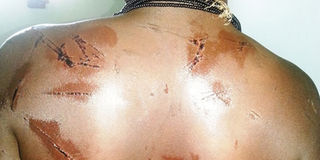Forced marriages still rampant in Karamoja

A 14-year-old girl who was beaten by her parents for refusing to get married to 78-year-old man in Moroto. PHOTO Steven Ariong
What you need to know:
Explained. Residents attribute the rising rate to poverty.
MOROTO. Despite the promulgation of laws prohibiting child and forced marriages in Uganda, the practice is still rampant in Karamoja sub-region with Moroto, Amudat, Nakapiripirit and Napak districts being the worst hit.
This was disclosed by the head of the Uganda Association of Women Lawyers Karamoja sub-office, Ms Mercy Munduru, during a consultation meeting with Karamoja leaders on how to curb the practice in Moroto last week.
Ms Munduru said FIDA receives about 20 cases of underage forced marriage on a weekly basis in the four districts.
Ms Munduru said despite government effort to construct schools in the region, Karimojong parents still have a negative attitude towards educating the girl child claiming it’s a delaying process for them to reap from their girls forcing them to get married so that they can get money and livestock.
Mr Peter Lokong, an elder and a resident of Mogoth parish in Rupa Sub-county, Moroto District acknowledged there was still rampant under-age marriages in the sub-region blaming it on the biting poverty in the region.
“Its poverty driving us to marry off our children but if our households were also stable like in other parts of the country, we would not be forcing children to get marriage,” he said.
Statistics
According to statistics gathered in 2010 to 2012 from UNFPA, UNICEF, WHO and World Bank, Uganda falls among the 15 worst African countries with high numbers of child brides. At 46 per cent of underage girls below 18 forced or lured in marriage, it is in the 11th position while Niger tops the list at 75 per cent followed by Chad with 72 per cent of child marriages. The statistics indicate that the countries with the worst child marriage scores also have the highest maternal mortality rates, highest adolescent fertility and constitute the greater majority of people living with HIV/AIDS.




